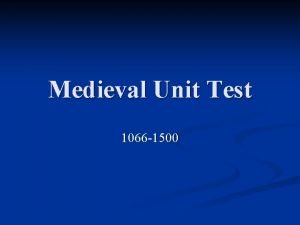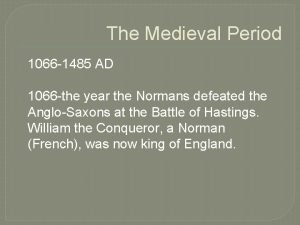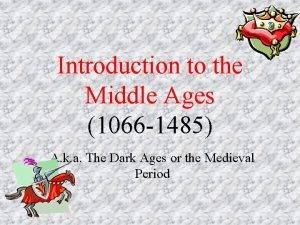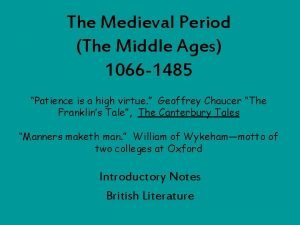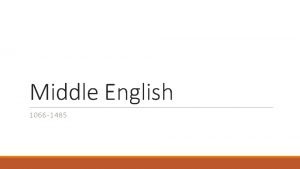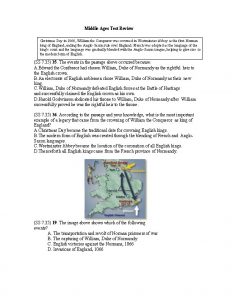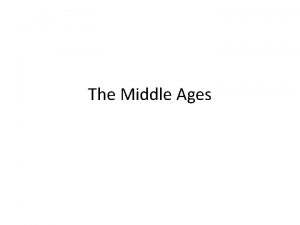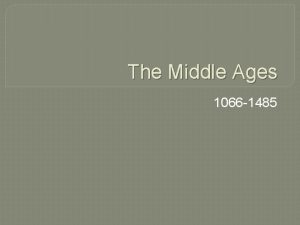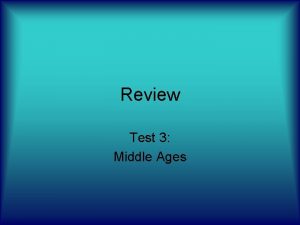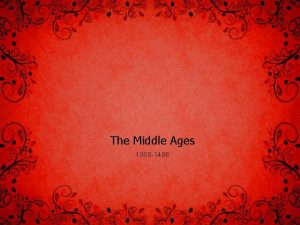Middle Ages Test Review Christmas Day in 1066








- Slides: 8

Middle Ages Test Review Christmas Day in 1066, William the Conqueror was crowned in Westminster Abbey as the first Norman king of England, ending the Anglo-Saxon rule over England. French was adopted as the language of the king's court and the language was gradually blended with the Anglo-Saxon tongue, helping to give rise to the modern form of English. (SS 7. 35) 35. The events in the passage above occurred because: A. Edward the Confessor had chosen William, Duke of Normandy as the rightful heir to the English crown. B. An electorate of English noblemen chose William, Duke of Normandy as their new king. C. William, Duke of Normandy defeated English forces at the Battle of Hastings and successfully claimed the English crown as his own. D. Harold Godwinson abdicated his throne to William, Duke of Normandy after William successfully proved he was the rightful heir to the throne. (SS 7. 35) 36. According to the passage and your knowledge, what is the most important example of a legacy that came from the crowning of William the Conqueror as king of England? A. Christmas Day became the traditional date for crowning English kings. B. The modern form of English was created through the blending of French and Anglo. Saxon languages. C. Westminster Abbey became the location of the coronation of all English kings. D. Thenceforth all English kings came from the French province of Normandy. (SS 7. 35) 19. The image above shows which of the following events? A. The transportation and revolt of Norman prisoners of war B. The capturing of William, Duke of Normandy C. English victories against the Normans, 1066 D. Invasions of England, 1066

(SS 7. 35) 12. What is the significance of the artwork in the above image? A. The artwork is part of the Bayeux Tapestry, which details the history of the Norman Invasion of England in 1066. B. The artwork shows the English defeating the Normans in the Battle of Hastings in 1066. C. This section of the Bayeux Tapestry shows the death of William, Duke of Normandy. D. The artwork shows Christians defeating Muslims during the First Crusade. The Battle of Hastings is often attributed with the title of "the battle that changed history". It is often given this title because of the huge impact the demise of the Saxon empire and the rise of a Norman king had on the country and the culture of England. (SS 7. 35) 9. In what ways did England’s culture change after the Battle of Hastings? A. England’s culture was now based on conquest, and for centuries afterward, English monarchs focused heavily on conquering foreign lands. B. English citizens embraced Norman culture and cherished having William as their new king. C. Norman law, language, and culture replaced Saxon culture, and the Normans introduced feudalism into England. D. William enforced martial law in England, and English citizens suffered under William’s heavy-handed rule. “The course of the papacy should not detract from other developments in the Western church. Monasticism emerged early in the Middle Ages and continued to play a vital role in maintaining the spiritual life of the church, keeping alive the culture of the Roman Empire and helping to educate the leaders of Christendom. An extensive mission enterprise launched by Gregory I was continued by his successors until all Europe had been brought into the church. Some spiritual reform took place within the church, spurred by outstanding leaders such as St. Francis of Assisi and St. Dominic. Universities were founded in major cities, culminating in the 13 th-century endeavors in theology, art, philosophy, logic, and the sciences. ” (SS 7. 39) 15. What was the role of the Catholic Church during the Middle Ages? A. The Catholic Church offered employment to peasants during the Middle Ages. B. The Catholic Church provided daily guidance for people of the Middle Ages. C. The Catholic Church chose all European leaders during the Middle Ages. D. The Catholic Church served as a religious, political, and intellectual institution.

(SS 7. 39) 7. How did monasticism influence the culture of the medieval world? A. Monks served as counsel to European monarchs. B. Monks were missionaries, spiritual leaders, and intellectuals who taught and converted Europeans to Christianity. C. Monks lived among the peasants, providing charity and hopeful guidance to those suffering under the feudal order of society. D. All of the above “Natural law is clearly distinguished from the eternal law—God himself or the principle of his governance of all creatures —on the one hand, and the divine law, i. e. , the positive law contained in the Bible, on the other. The eternal law is the ground of the natural law, and natural law must be supplemented by the divine law if man is to reach eternal felicity and if no evil is to remain unpunished. ” (SS 7. 39) 7. Which medieval theologian based his philosophy on the concept of natural law? A. Thomas Aquinas B. Francis of Assisi C. Thomas More D. Franciscus Patricius (SS 7. 39) 22. Which institution is responsible for the establishment of universities throughout Europe during the Middle Ages? A. The Greek Orthodox Church B. The English Monarchy C. The Catholic Church D. The Byzantine Empire • : still used for many purposes, mostly for liturgical language of the Roman Catholic Church 10. Which term best completes the blank in the definition above? A. English B. Latin C. Greek D. None of the above

Use the map below and your knowledge to answer 11 & 12. 11. Why were rivers important to early Europeans? A. Rivers allowed people to trade throughout Europe, and also provided protection. B. Rivers allowed European peoples to wage war on each other. C. Rivers provided a great source of drinking water and swimming areas. D. Rivers had little influence on early Europeans. 12. How did European mountain ranges influence Europe’s cultural development? A. Like the rivers, the mountains encouraged the growth of independent territories. B. Europeans developed a great tradition of mountain climbing and skiing. C. Mountain goats became a staple in European diets. D. The mountains encouraged Europeans to migrate to coastal areas. Use the chart and your knowledge to answer 13. What is feudalism? A. Feudalism is training to be a knight in order to move up in society. B. Feudalism is the system of service between a lord and his loyal vassals. C. Feudalism is a relationship between knights and ladies, which enforces the ideas of chivalry in European society. D. None of these.

14. What explains the development of cities and towns during the Middle Ages? A. Foreigners came from Asia and set up new cities and towns in Europe. B. Feudalism enforced the idea of community so Europeans were eager to set up cities and towns all over Europe. C. Europeans got better at farming, which led to more food, population growth, and the establishment of cities and towns. D. No one really knows. Use the map and your knowledge to answer 15. How was Christianity spread all over Europe? A. Europeans were forced to become Christian or die. B. Many Europeans loved to read, and the Bible was the only available book. C. In 597, Pope Gregory I sent out Catholic missionaries (usually monks) to convert Europeans to Christianity. D. Christians always had big families, so their population grew quickly. Use the pictures and your knowledge to answer 16 & 17. 16. Why was Charlemagne concerned when the Pope crowned him emperor in 800? A. Charlemagne was concerned that the Pope might be viewed with too much power because of this. B. Charlemagne was concerned the Pope gave him the wrong crown. C. Charlemagne was concerned because he was not actually a Christian. D. The Pope at the time was corrupt, and Charlemagne did not trust him.

17. . A. European kings no longer wanted to be Christians. B. Popes wanted to be emperors themselves and take the kings’ positions. C. European kings wanted church leaders to obey them, but Popes believed the kings should obey the Church. D. No real power struggle existed. Use the text and your knowledge to answer 18. The Battle of Hastings is often attributed with the title of "the battle that changed history". It is often given this title because of the huge impact the demise of the Saxon empire and the rise of a Norman king had on the country and the culture of England. 18. How did the Battle of Hastings in 1066 eventually change the culture of England? A. Feudalism was brought to England, and the blending of French and the Anglo-Saxon language created modern English. B. William the Conqueror made England an incredibly poor country. C. The Battle of Hastings created a massive famine that destroyed all of England ’s crops. D. English culture remained largely unchanged after the Battle of Hastings. Use the image and your knowledge to answer 19. List three effects the Crusades had on European culture. A. New knowledge (ship-building, map-drawing); Eastern goods (spices, lemons sugar); Weakened feudalism (nobles sold their land freed their serfs) B. Better weapons, population increase, and more money C. New languages, a new money system, and a violent end to feudalism D. None of these Use the image and your knowledge to answer 20.

20. How did the Black Death influence both the European economy and society during the Middle Ages? A. The Black Death had little effect on Europe’s economy and society. B. The Black Death made European doctors very wealthy. C. Serfs led a violent revolution as they blamed the disease on rich landowners. D. Trade declined, and a shortage of workers weakened feudalism as serfs demanded pay and more rights. 21. How did large bodies of water influence Europe’s cultural development? A. Large bodies of water influenced Europeans’ religious beliefs. B. Large bodies of water allowed Europeans to build amazing fleets of ships. C. Culture and large bodies of water are not inter-related. D. Large bodies of water separated areas and caused many different cultures to develop. 22. How did the fertile soil of the North European Plain affect Europe? A. The North European Plain served as a good site for European battlefields. B. The North European Plain grew quickly as a center of European population. C. The North European Plain divided Europe and Asia. D. The soil of the European Plain is not fertile. 23. What was the role of the Mediterranean Sea in Europe’s development? A. The Mediterranean Sea provided food, routes for trade, colonization, and war. B. The beaches of the Mediterranean Sea caused Europeans to become lazy tourists. C. Many wars were fought over control of Mediterranean Sea trade routes. D. The Mediterranean Sea had little impact on Europe’s development. 24. Why did vassals serve lords in battle? A. In exchange for money B. In exchange for land C. In exchange for serfs D. In exchange for vacation days 25. Why was the feudal order of European society successful? A. Serfs were poor and had no chance of moving up in society. B. Both lords and knights believed in feudalism. C. The king said feudalism was law, and that is why it was successful. D. Feudalism was not successful. 26. What was the place of a serf in European feudalism? A. Serfs were at the top of feudal society. B. Serfs could be at any place in European society, depending on how much money they had. C. feudal Serfs were at the bottom of society. D. Serfs were not a part of feudal society. 27. What does the name Charlemagne mean? A. Charles the Conqueror B. Charles the Maniac C. Charlie Magne D. Charles the Great 28. What is a concordat? A. An agreement between the Pope and the ruler of a country B. A declaration of war between the Church and the government C. A notice of wrongdoing between the Church and the people D. A formal letter of a split between the Pope and the ruler of a country

29. How did William, Duke of Normandy become William the Conqueror? A. He conquered all of Europe in 1066. B. He won the Battle of Hastings in 1066 and was crowned the king of England. C. He defeated Charlemagne at the Battle of Hastings. D. His French soldiers were particularly brutal in their battle tactics. 30. What was the purpose of the Magna Carta? A. The Magna Carta placed limits on the King of England’s power and gave rights to free Englishmen. B. The Magna Carta created a widespread European money system and placed limits on the king’s power. C. The Magna Carta enacted laws against women’s rights and forced King John to retire. D. All of these 31. What was the Christian goal of the Crusades? A. To kill all Muslims and non-Christians in Europe B. To capture England, Rome, and Constantinople C. To capture Jerusalem and free the Holy Land, where Jesus had lived, from the Muslims D. To resurrect Jesus and create a new Christian world order 32. How did the Black Death arrive in Europe? A. Rat-infested caravans and ships brought the disease across regions from Asia. B. It was brought through evaporation of moisture in infected cities in Asia and fell on Europe in the form of rain. C. It was an airborne disease so it spread easily across Asia and Europe. D. It was spread through contaminated food. 33. About how many people died in Europe because of the Black Death? A. About 450 million B. About 150 million C. of About three-fourths Europe’s population D. About half of Europe’s population 34. What were the important changes or developments that came about as a result of William the Conqueror’s victory at the Battle of Hastings, 1066? A. Describe the importance of monks, monasteries, and the Catholic Church in medieval Europe.
 The middle ages 1066-1485 unit test
The middle ages 1066-1485 unit test The middle ages 1066 to 1485 unit test
The middle ages 1066 to 1485 unit test The middle ages 1066 to 1485 unit test closed book
The middle ages 1066 to 1485 unit test closed book Middle english period 1066 to 1485
Middle english period 1066 to 1485 The middle ages 1066 to 1485 unit introduction
The middle ages 1066 to 1485 unit introduction Christmas day 1066
Christmas day 1066 Why are the middle ages called the dark ages
Why are the middle ages called the dark ages Dark ages vs middle ages
Dark ages vs middle ages Day 1 day 2 day 3 day 4
Day 1 day 2 day 3 day 4
